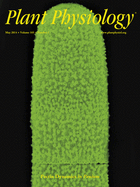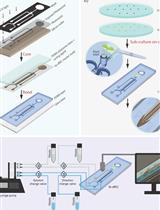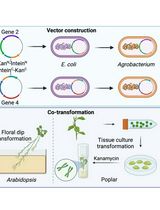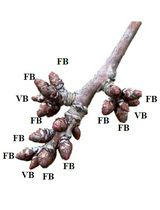- EN - English
- CN - 中文
Agrobacterium-mediated Transformation of Mature Ginseng Embryos
农杆菌介导的成熟人参胚胎的遗传转化
发布: 2014年12月20日第4卷第24期 DOI: 10.21769/BioProtoc.1362 浏览次数: 12265
评审: Tie Liu
Abstract
Ginseng refers to species within the genus Panax and is a slow-growing perennial herb from the Araliaceae family. The most widely used Panax species is Panax ginseng Meyer (Korean ginseng). Panax japonicus (Japanese ginseng), Panax notoginseng (Chinese ginseng), and Panax quinquefolium (American ginseng). Due to the various pharmaceutical importance of ginsenosides, ginseng plant has been cultivated for its highly valued root over 2,000 years as a medicinal plant in East Asian countries particularly in China, Korea, and Japan and North America. Korean ginseng (Panax ginseng C. A. Meyer) consists of nine cultivars from three Jakyung, Chungkyung, and Hwangsook lines. Cultivar “Yunpoong” has characteristics to have more axillary shoots and lateral roots compared to other cultivars. Thus “Yunpoong”: Ginseng seeds are relatively more feasible for regeneration of adventitious roots during gene transformation. Here, we describe how to prepare and treat ginseng seeds after harvest till the ginseng immature embryos are ready for the germination, and to be used in Agrobacterium tumefaciens-mediated gene transformation.
Keywords: Panax ginseng (人参)Materials and Reagents
- Ginseng seeds, in which zygotic embryos were in a mature state (4 mm in length)
- Agrobacterium tumefaciens C58C1 (pMP90) strain
- Binary (pCAMBIA1390) vector
- MS powder (Duchefa Biochemie, catalog number: M0222 )
- Sucrose (Duchefa Biochemie, catalog number: S0809 )
- 2-(N-morpholino) ethanesulfonic acid (MES) monohydrate (MB cell, catalog number: MB-M4837 )
- Phytoagar (Duchefa Biochemie, catalog number: P1003) or Gelrite (Duchefa Biochemie, catalog number: G1101)
- Yeast extract (Duchefa Biochemie, catalog number: Y1333 )
- Peptone (Duchefa Biochemie, catalog number: P1328 )
- NaCl (Affymetrix, catalog number: 4171746 )
- Bactoagar (BD, catalog number: 214010 )
- Hygromycin (Duchefa Biochemie, catalog number: H0192 )
- Kanamycin (Duchefa Biochemie, catalog number: K0126 )
- Cefotaxime (Duchefa Biochemie, catalog number: C0111 )
- 6-benzylaminopurine (BAP) (Duchefa Biochemie, catalog number: B0904 )
- 2,4-dichlorophenoxyacetic acid (2,4-D) (Duchefa Biochemie, catalog number: D0911 )
- Indole-3-butyric acid (IBA) (Duchefa Biochemie, catalog number: I0902 )
- Sucrose
- Phyto agar
- 70% ethyl alcohol (EtOH)
- 2% (v/v) sodium hypochlorite (NaOCl) (Sigma-Aldrich, catalog number: 425044-1L )
- B5 medium (Duchefa Biochemie, catalog number: G0209 )
- MS (Murashige & Skoog) medium (see Recipes)
- YEP medium (see Recipes)
- Antibiotics stock solution (in ddH2O) (see Recipes)
- Plant growth regulators stock solution (see Recipes)
Equipment
- Laminar flow cabinet (HEPA filter 99.99% efficient on particle of 0.3 μ and vertical type)
- Shaking incubator (100~200 rpm on a gyratory shaker)
- Centrifuge (3,000 x g) (Labnet International, catalog number: C2500-R-230V )
- Micropipette
- Forceps (Phoenix Technologies, catalog number: ESD-16 )
- Erlenmeyer flask (50/100 ml) or autoclavable plastic tube for seed sterilization
- Autoclave machine
- Growth chamber (23 °C ± 2 °C)
- Sterile filter paper
- Petri dish
Procedure
文章信息
版权信息
© 2014 The Authors; exclusive licensee Bio-protocol LLC.
如何引用
Readers should cite both the Bio-protocol article and the original research article where this protocol was used:
- Lee, O. R., Han, J. H. and Kim, Y. (2014). Agrobacterium-mediated Transformation of Mature Ginseng Embryos. Bio-protocol 4(24): e1362. DOI: 10.21769/BioProtoc.1362.
- Kim, Y. J., Lee, O. R., Oh, J. Y., Jang, M. G. and Yang, D. C. (2014). Functional analysis of 3-hydroxy-3-methylglutaryl coenzyme a reductase encoding genes in triterpene saponin-producing ginseng. Plant Physiol 165(1): 373-387.
分类
植物科学 > 植物转化 > 农杆菌介导的转化方法
植物科学 > 植物生理学 > 植物生长
分子生物学 > DNA > 转化
您对这篇实验方法有问题吗?
在此处发布您的问题,我们将邀请本文作者来回答。同时,我们会将您的问题发布到Bio-protocol Exchange,以便寻求社区成员的帮助。
Share
Bluesky
X
Copy link












